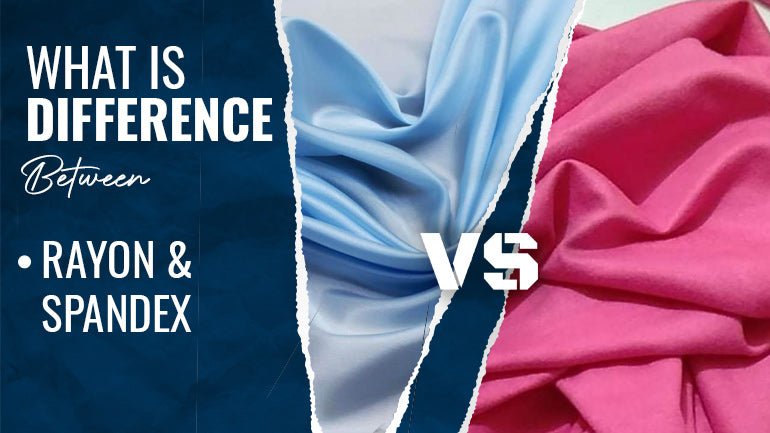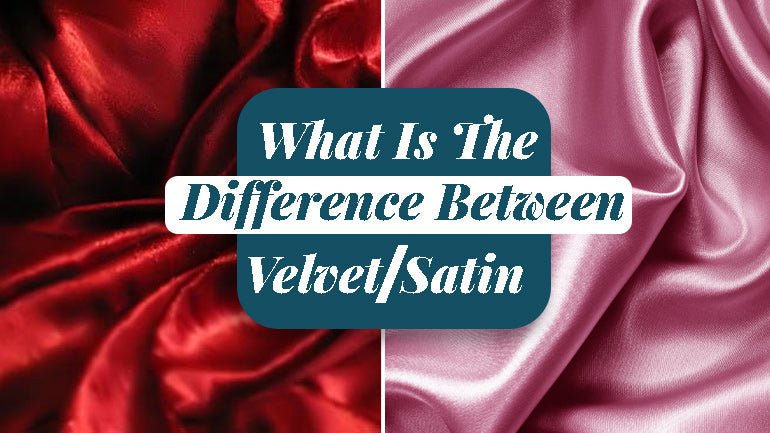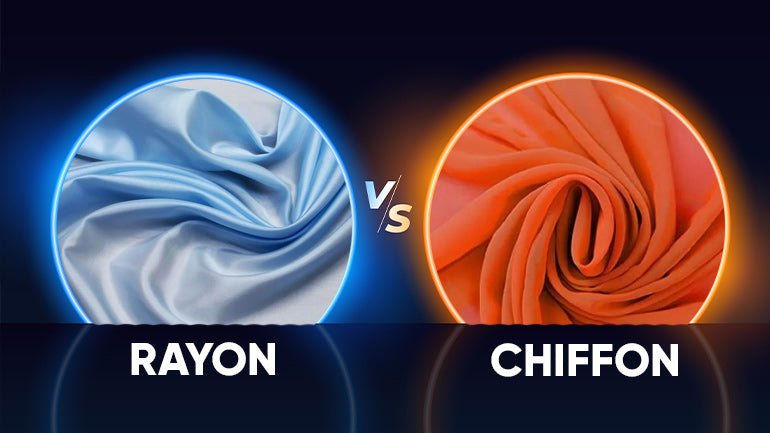Fabrics play an important role in clothing, dictating comfort, functionality, and the visual appeal of our attire.
If you're in search of something stretchy that will also last for a long time You may be confused between spandex fabric and rayon fabric. Because both are great fabrics in their own way and are widely used nowadays.
These fabrics may seem similar on the surface, yet they possess distinct properties that set them apart, defining their roles in the diverse landscape of clothing.
Everyone doesn’t have an idea about The Difference Between Rayon and Spandex. Fabrics are the very threads that weave together the essence of fashion, defining not just the comfort and aesthetics of clothing but also their functionality. In this intricate tapestry of textile choices, two distinct fabrics, spandex and rayon, stand out for their remarkable characteristics. The battle between these two fabrics, often referred to as "rayon vs. spandex," sparks debates over which is better suited for various clothing needs.
Here we will discuss the key differences between these two textiles and Which is better: rayon or spandex? and their diverse properties and applications in the world of fashion
Key Differences Between Rayon and Spandex Fabric
Fabric Type
Spandex: At the heart of spandex lies its synthetic elastomeric nature, a marvel that grants it unparalleled stretchiness and elasticity. This synthetic fiber is meticulously crafted from polymer-based chemicals through a complex manufacturing process. This careful engineering gives rise to a fabric that can astonishingly extend up to 500% of its original length and promptly spring back to its initial form.
Rayon: In contrast, rayon represents a semi-synthetic cellulose fiber that originates from wood pulp. While it does exhibit a certain degree of natural stretch, it falls short of the exceptional elasticity of spandex. Rayon’s true charm rests in its soft, cascading texture, which lends itself to comfortable, flowing designs. However, it's important to note that rayon may not possess the same shape retention as spandex and can be susceptible to wrinkling. The material finds its niche in creating lightweight and graceful garments such as dresses, blouses, and delicate outerwear.
Stretchiness
Spandex: The hallmark feature of spandex is its remarkable stretchiness and elasticity, stemming from its status as a synthetic elastomeric fiber produced from polymer-based chemicals. The molecular structure of spandex grants it the capacity to elongate significantly without relinquishing its original shape. With the ability to stretch up to 500% of its initial length, spandex empowers wearers with optimal flexibility and unrestricted movement.
Rayon: Rayon, on the other hand, possesses a moderate stretchiness that can be attributed to its semi-synthetic cellulose origin. While it does offer some innate stretch, it falls far short of the extent provided by spandex. As such, rayon is ill-suited for garments necessitating extensive stretch and recovery.
Comfort
Spandex: Owing to its remarkable stretch and body-conforming nature, spandex emerges as the epitome of comfort across a multitude of activities. Its elasticity ensures seamless integration with the body, affording unencumbered movement. Sporting and athletic wear widely capitalize on this aspect, as spandex simultaneously provides support and freedom.
Rayon: The comfort offered by rayon stems from its plush, smooth texture that gently drapes over the body. The fabric’s lightweight demeanor further enhances its comfort quotient, rendering it an excellent choice for warmer weather. Rayon’s breathability, which allows for better air circulation, mitigates the likelihood of overheating and contributes to an overall pleasurable wearing experience.
Shape Retention
Spandex: One of the spandex’s most notable merits lies in its exceptional shape retention. Even after substantial stretching, the fabric promptly rebounds to its original form. This attribute proves invaluable for garments demanding consistent shape maintenance, particularly after strenuous activities or prolonged usage.
Rayon: In terms of shape retention, rayon's performance falls between moderate and satisfactory. While not as potent as spandex in this regard, it nevertheless offers acceptable durability. Over time, garments crafted from rayon may exhibit diminished shape, particularly with frequent washing or suboptimal care practices. To preserve the integrity of rayon garments, meticulous handling and care are essential.
Breathability:
Spandex: Regrettably, breathability is not a salient trait of spandex. Its tight and stretchy composition tends to hinder air circulation, which in turn can lead to moisture retention—especially during intense physical exertion. This trapped moisture can lead to discomfort and unwanted sweat accumulation.
Rayon: In stark contrast, rayon demonstrates relatively higher breathability compared to spandex. The fabric’s semi-synthetic origin facilitates improved air permeability, rendering it a suitable choice for clothing intended for warmer conditions. Rayon’s breathable nature acts as a regulator of body temperature and impedes the buildup of moisture, thereby bestowing a comfortable and cool wearing experience—particularly in humid climates.
Durability
Spandex: Durability is a notable hallmark of spandex, attributable to its robust resistance against wear and tear. The synthetic elastomeric fibers employed in its creation imbue it with considerable strength and longevity. Even in the face of persistent stretching and movement, spandex retains its shape and elasticity, qualifying it for long-lasting and high-performance garments.
Rayon: The durability of rayon can be described as moderate, falling short of the sturdiness exhibited by spandex. Although a resilient fabric, rayon is comparatively susceptible to fraying and pilling over time, particularly under conditions of frequent friction. Additionally, the presence of moisture can weaken its fibers, rendering careful maintenance imperative for prolonging the lifespan of rayon garments.
Wrinkle Resistance
Spandex: The elastic nature of spandex renders it highly resistant to wrinkles, even after being stretched or folded. This attribute makes it an ideal choice for garments demanding a sleek appearance amidst constant movement. Activewear and compression clothing are beneficiaries of spandex's wrinkle-resistant charm.
Rayon: Rayon's comfort comes at a cost—while it boasts a soft drape, it is not as wrinkle-resistant as spandex. The fabric's propensity to crease, particularly after prolonged sitting or storage, demands careful consideration during garment selection. Ironing or steaming might be necessary to restore rayon garments' smooth appeal.
Uses
Spandex: Spandex's stretching and flexibility place it at the forefront of sportswear and activewear. Its snug fit and support make it an indispensable component of leggings, swimwear, and compression garments. The fusion of spandex with other fabrics extends its reach, enhancing stretch in various clothing types like jeans and fitted tops.
Rayon: Rayon's characteristic softness and draping quality make it a staple for comfortable, flowing ensembles. Its breathability adds to its allure, particularly in warm weather clothing like dresses, blouses, and lightweight outerwear. However, the absence of spandex's elasticity limits rayon's use in garments requiring high stretch or support.
Drapability
Spandex: Spandex isn't celebrated for its drapability. While it clings well to the body, it doesn't offer the graceful drapes of some other fabrics. Its purpose revolves around stretch and support rather than creating loose, flowy silhouettes.
Rayon: Rayon shines when it comes to drapability. Its fluid drape and lightweight nature enable it to cascade elegantly, giving birth to graceful and flowing attire. This quality makes it an ideal choice for dresses, skirts, and blouses where a relaxed and flattering fit is the goal.
Production Process
Spandex: Spandex's intricate manufacturing process involves polymer-based chemicals and specialized equipment. This complexity and chemical intensity make spandex less environmentally friendly compared to natural fibers.
Rayon: Rayon's production, on the other hand, takes a different route. It is often labeled as semi-synthetic because it originates from natural materials, predominantly wood pulp from trees. The wood pulp undergoes chemical treatment to yield the cellulose fibers used in rayon fabric. Though not entirely natural, rayon is considered more sustainable than fully synthetic fabrics like spandex, thanks to its partial reliance on renewable resources.
Elasticity Recovery
Spandex: One of spandex's defining characteristics is its impressive elasticity recovery. This property allows it to bounce back to its original shape swiftly after being stretched. Such resilience is indispensable for garments that require consistent support and shape retention, including activewear and compression garments. Spandex's high elasticity recovery ensures that the fabric maintains its snug fit even after rigorous physical activities or repeated wear.
Rayon: Conversely, rayon exhibits a more moderate elasticity recovery. While it does possess some inherent stretch, it falls short of spandex's remarkable rebounding capabilities. Over time, repeated stretching can cause a loss of elasticity in rayon garments, preventing it from springing back to its original form. This limitation means that rayon is not the fabric of choice for garments that demand extensive stretch and recovery.
Moisture Absorption
Spandex: The battle between these fabrics continues in the world of moisture absorption. Spandex, with its tightly woven fibers, boasts low moisture absorption capabilities. While this feature can be advantageous during intense physical activities by limiting moisture retention, it can also lead to discomfort during prolonged wear as sweat isn't effectively wicked away from the skin.
Rayon: Rayon, on the other hand, stands as a champion of moisture absorption. Its fibers can adeptly absorb moisture, creating a cooling effect that renders rayon garments comfortable, particularly in hot and humid conditions. Rayon's breathability promotes better air circulation, which in turn minimizes sweat accumulation, enhancing the overall comfort of the wearer.
Shrinkage
Spandex: Spandex experiences minimal shrinkage due to its synthetic nature and inherent elasticity. Washing and drying spandex garments do not compromise their original dimensions, ensuring their shape and fit are maintained over time.
Rayon: Rayon, however, can undergo shrinkage when exposed to water and heat during laundering. The degree of shrinkage varies based on the specific type of rayon and adherence to proper care instructions. To mitigate shrinkage, it is imperative to follow the recommended washing and drying methods for rayon garments.
Pilling
Spandex: Resilience is spandex's forte, extending to its resistance against pilling. Its tightly-woven, elastic structure thwarts the emergence of those pesky fabric pills, even after repeated usage and washes. As a result, spandex-infused garments retain their sleek allure over an extended period, showcasing a smooth facade that defies wear and tear.
Rayon: The gentle nature of rayon leaves it vulnerable to pilling, particularly in areas of consistent friction or rubbing. Pilling occurs when loose fibers intertwine, manifesting as tiny balls or pills on the fabric's surface. To alleviate pilling in rayon garments, adopting a gentle washing approach and avoiding abrasive surfaces becomes imperative.
Stretch
Spandex: The tale of spandex's stretch memory narrates a saga of resilience. With a remarkable ability to retain its original shape and elasticity after numerous stretches and movements, spandex ensures that garments maintain their fit and support through the trials of time.
Rayon: While rayon possesses some degree of stretch memory, it's not as formidable as spandex. Rayon may regain its shape after mild stretching, but repeated, excessive stress could compromise its elasticity. Overstretching might lead to a gradual erosion of stretch memory in rayon garments.
Allergies
Spandex: As a synthetic fiber, spandex carries the potential to incite allergies or skin sensitivities in certain individuals. Direct contact with spandex fabric might lead to skin irritation or allergic reactions. However, such reactions are relatively uncommon, and most people can don spandex garments without any discomfort.
Rayon: Rayon, in comparison, boasts a greater degree of hypoallergenic properties. As a semi-synthetic fiber birthed from natural materials, rayon is less likely to trigger allergies or skin irritations. Individuals endowed with sensitive skin may find rayon an amicable companion due to its gentler disposition, less prone to evoking allergic reactions.
Cost
Spandex: The intricacies of spandex's manufacturing process and the specialized materials involved render it a pricier option. This expense often extends to the final cost of garments that incorporate significant amounts of spandex, offering enhanced stretch and support.
Rayon: Rayon emerges as the more budget-friendly contender in this duel. The relatively straightforward production process, coupled with the cost-effectiveness of its raw material (wood pulp), positions rayon as a more accessible choice in terms of pricing.
Production Sustainability
Spandex: The production of spandex raises environmental concerns, as it relies on fossil fuels and energy-intensive procedures. Being a synthetic fiber, spandex lacks biodegradability and contributes to the scourge of microplastic pollution when its garments are laundered. Consequently, spandex's environmental credentials fall short compared to its biodegradable counterparts.
Rayon: Rayon's sustainability profile straddles a middle ground. While derived from natural materials (wood pulp), the production process isn't without its chemical interventions. However, eco-conscious efforts are made to mitigate its ecological footprint. Some variants of rayon, such as modal and lyocell, embrace eco-friendly closed-loop processes that curtail water and chemical waste.
Environmental Impact
Spandex: The environmental impact of spandex overshadows that of rayon. Its production demands petrochemicals and energy-intensive techniques, contributing to greenhouse gas emissions. Furthermore, spandex garments contribute to microplastic pollution when washed, which detrimentally affects aquatic ecosystems.
Rayon: Rayon's environmental consequences are multifaceted. Traditional rayon manufacturing involves chemicals and potentially fuels deforestation if not sourced sustainably.
Color Retention
Spandex: Vibrancy prevails in spandex's color retention capabilities. The synthetic fibers adeptly capture dyes, allowing spandex garments to maintain their vibrant hues despite repeated washes and exposure to sunlight.
Rayon: Rayon's color retention ventures into a spectrum of possibilities. It largely depends on the quality of the fabric and the dyeing techniques employed. Some forms of rayon may exhibit susceptibility to fading over time, particularly when subjected to direct sunlight or aggressive washing practices.
Explore the depths of What is Difference Between Rayon and Cotton Fabric?
Rayon vs Spandex: Comparison Table
|
Features |
Spandex |
Rayon |
|
Fabric Type |
Synthetic elastomeric fiber |
Semi-synthetic cellulose fiber |
|
Stretchiness |
Exceptional, up to 500% elongation |
Moderate stretch, falls short of spandex |
|
Comfort |
Body-conforming, ideal for active wear |
Soft, cascading texture, great for comfort |
|
Shape Retention |
Excellent shape retention |
Moderate shape retention |
|
Breathability |
Limited breathability, retains moisture |
Relatively higher breathability, cooler wear |
|
Durability |
Highly durable, withstands wear and tear |
Moderate durability, susceptible to fraying |
|
Wrinkle Resistance |
Wrinkle-resistant, maintains sleek look |
Not as wrinkle-resistant, may crease |
|
Uses |
Sportswear, activewear, compression garments |
Flowing ensembles, dresses, blouses, outerwear |
|
Drapability |
Not known for drapability |
Excellent drapability, graceful flow |
|
Elasticity Recovery |
Impressive recovery after stretching |
Moderate recovery, not as resilient |
|
Moisture Absorption |
Low moisture absorption, may retain sweat |
High moisture absorption, cooling effect |
|
Shrinkage |
Minimal shrinkage after laundering |
Can shrink when exposed to water and heat |
|
Pilling |
Resistant to pilling |
Vulnerable to pilling, requires gentle care |
|
Allergies |
Potential for skin irritation in some individuals |
Hypoallergenic, less likely to cause reactions |
|
Cost |
Pricier due to complex manufacturing process |
More budget-friendly |
|
Production Sustainability |
Not environmentally friendly |
Mixed environmental impact, some variants more sustainable |
|
Color Retention |
Vibrant color retention |
Varied, depends on fabric quality and dyeing |
|
Environmental Impact |
High impact due to fossil fuels and microplastics |
Moderate impact, potential for deforestation |
You may also want to learn Difference Between Rayon and Silk Fabric.
Wrapping up
Spandex and rayon both fabrics have unique features and uses. Our guide will help you to choose the best fabric according to your preferences. The decision between these two materials ultimately comes down to the purpose of the garment and the desired level of comfort and style. So whether you're hitting the gym or strolling through a summer market, there's a fabric that suits your needs perfectly.



